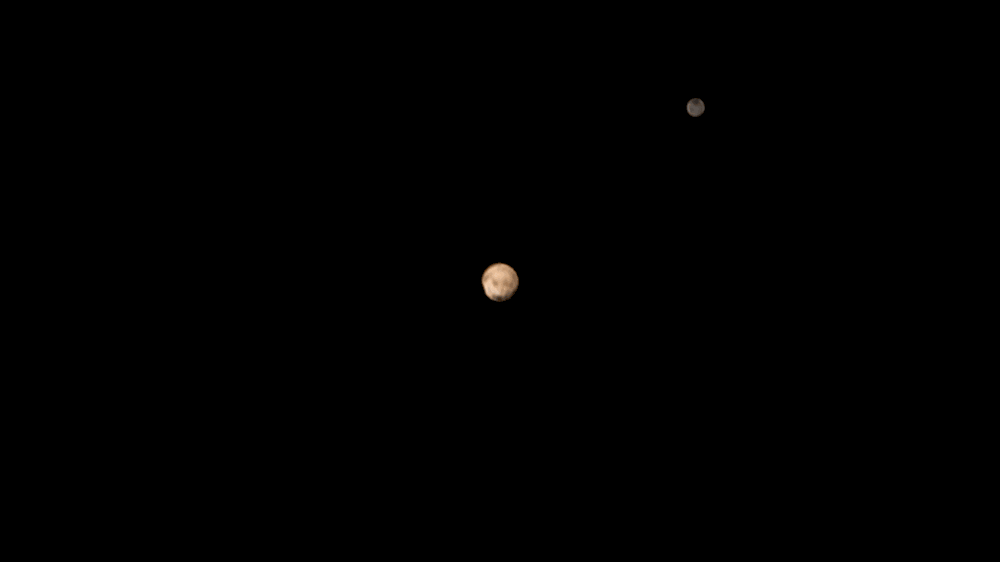'Close up' with Pluto – NASA New Horizons arrival imminent



DLR supports German scientists in the REX radio experiment
After a nine-and-a half year journey, the NASA New Horizons spacecraft will fly past the dwarf planet Pluto – approximately 4.8 billion kilometres from Earth – at 13:50 CEST on 14 July 2015. This is the first time that the former 'ninth planet' in the Solar System will receive a visitor. It is also the first time that this celestial body will be examined 'up close', at a distance of roughly 12,500 kilometres, and less than Earth’s diameter.
Seven scientific experiments will record images, spectra and physical measurement values during the flyby phase. On board the spacecraft are two plasma instruments (PEPSSI and SWAP), one dust detector (Venetia), a radio experiment (REX) and three optical devices: the UV spectrometer Alice and the LORRI and Ralph high-resolution camera systems. REX will use radio waves to examine the atmospheres and determine the surface temperatures and masses of Pluto and its largest moon, Charon. It is the only instrument on New Horizons that involves a contribution by German scientists, namely the planetary researchers at the Rhenish Institute for Environmental Research at the University of Cologne (EURAD).
The German Aerospace Center (Deutsches Zentrum für Luft- und Raumfahrt; DLR) Space Administration has supported Martin Pätzold’s participation in the REX experiment with funds provided by the German Federal Ministry for Economic Affairs and Energy (Bundesministerium für Wirtschaft und Energie; BMWi). "Our role here is to act as co-investigators, which means we will conduct two experiments while New Horizons flies past Pluto," reports Pätzold, who is experiencing the 'hot phase' of the mission in the Applied Physics Laboratory (APL) at Johns Hopkins University in Laurel (Maryland), USA, the institute responsible for implementing and controlling the mission on behalf of NASA. "We will measure the surface temperatures on Pluto and its moon Charon in the microwave range. We also want to directly determine the masses and densities of Pluto and Charon. Mass and density provide important insights into the inner structure of planetary bodies and their origin," Pätzold continues.
REX is the first experiment in which radio signals are sent to a spacecraft from Earth; standard practice is for a spacecraft to send radio signals to Earth for analysis. In this case, however, the intention is for REX to measure a deflection and weakening of the signals sent from Earth caused by the possible thin atmospheres surrounding Pluto and Charon. This could permit conclusions to be drawn about the temperatures and pressures prevailing close to the surfaces.
An icy body, one billion kilometres from the Sun
"Pluto, which has a diameter of approximately 2310 kilometres, and its slightly smaller companion, Charon, are almost entirely uncharted terrain for planetary researchers; this is why scientists around the world are waiting excitedly to receive the images and measurements of New Horizons," says Tilman Spohn, Director of the DLR Institute of Planetary Research in Berlin.
The scientists hope that the images will help them understand the geology and the underlying processes of Pluto and Charon. In addition, the surface constituents will be subjected to geochemical and mineralogical analysis. The thin atmosphere, consisting of vaporised ice compounds, will also be examined. Furthermore, there are hopes that the geophysical measurements will help decode the inner structure of Pluto and Charon's dual-body system.
"Pluto may even be a suitable object to search for ecological niches in which the development of simple life forms would be conceivable," says Spohn, adding: "Pluto is the largest known object in the Edgeworth-Kuiper belt, a zone five to 10 billion kilometres from the Sun, beyond Neptune's orbit, inhabited by icy bodies, approximately. As is the case with asteroids and comets, the absence of geological processes has left these 'ice dwarfs' practically unaltered since the first days of their emergence. This means that Pluto could have a lot to teach us about the earliest era of the Solar System, just like Comet 67P, which we are currently investigating using the Rosetta orbiter."
However, the extremely high speed – roughly 50,000 kilometres per hour – at which New Horizons is approaching Pluto makes it technically impossible to enter orbit.
APL expects the first close-up images of Pluto and Charon to be available on 15 July 2015. However, the long signal propagation delay in radio communication with the spacecraft, which is almost four-and-a-half hours one-way, means it will take over a year before the onboard computer has transmitted all the scientific data to Earth.
The fastest spacecraft of all time
New Horizons was launched from Cape Canaveral (Florida) on 19 January 2006. The approximately 500-kilogram orbiter flew past Jupiter on 28 February 2007; the flyby accelerated the spacecraft to its final speed; the flyby of Pluto and Charon will take place at 50,400 kilometres per hour, making New Horizons the fastest spacecraft ever to travel across the Solar System. Like the far away planets Uranus and Neptune, Pluto is not visible with the naked eye from Earth. In 2006, the International Astronomical Union reclassified Pluto as a dwarf planet. The main argument was that Pluto has not yet removed from its orbit other, smaller bodies, which is what the eight other 'classic' planets have achieved. New Horizons started its observations of Pluto and Charon in January 2015. The dwarf planet has five moons in total, but so far there have been few meaningful telescope observations of the entire Pluto system, and only a small number of images acquired using the Hubble Space Telescope.
